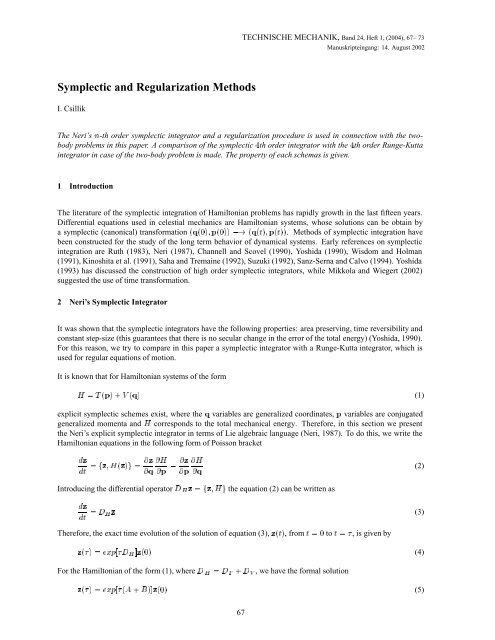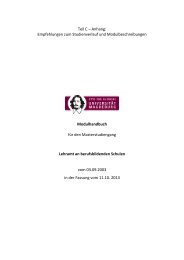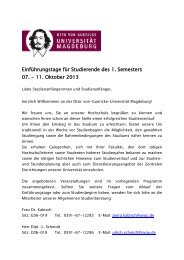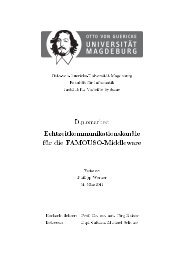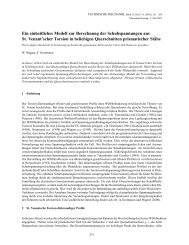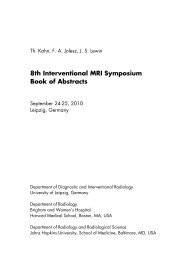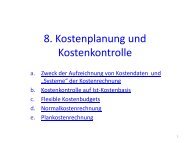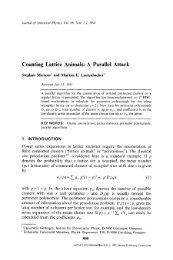Symplectic and Regularization Methods
Symplectic and Regularization Methods
Symplectic and Regularization Methods
You also want an ePaper? Increase the reach of your titles
YUMPU automatically turns print PDFs into web optimized ePapers that Google loves.
TECHNISCHE MECHANIK, B<strong>and</strong> 24, Heft 1, (2004), 67– 73<br />
Manuskripteingang: 14. August 2002<br />
<strong>Symplectic</strong> <strong>and</strong> <strong>Regularization</strong> <strong>Methods</strong><br />
I. Csillik<br />
The Neri’s Ò-th order symplectic integrator <strong>and</strong> a regularization procedure is used in connection with the twobody<br />
problems in this paper. A comparison of the symplectic th order integrator with the th order Runge-Kutta<br />
integrator in case of the two-body problem is made. The property of each schemas is given.<br />
1 Introduction<br />
The literature of the symplectic integration of Hamiltonian problems has rapidly growth in the last fifteen years.<br />
Differential equations used in celestial mechanics are Hamiltonian systems, whose solutions can be obtain by<br />
a symplectic (canonical) transformation ´Õ´¼µ Ô´¼µµ ´Õ´Øµ Դصµ. <strong>Methods</strong> of symplectic integration have<br />
been constructed for the study of the long term behavior of dynamical systems. Early references on symplectic<br />
integration are Ruth (1983), Neri (1987), Channell <strong>and</strong> Scovel (1990), Yoshida (1990), Wisdom <strong>and</strong> Holman<br />
(1991), Kinoshita et al. (1991), Saha <strong>and</strong> Tremaine (1992), Suzuki (1992), Sanz-Serna <strong>and</strong> Calvo (1994). Yoshida<br />
(1993) has discussed the construction of high order symplectic integrators, while Mikkola <strong>and</strong> Wiegert (2002)<br />
suggested the use of time transformation.<br />
2 Neri’s <strong>Symplectic</strong> Integrator<br />
It was shown that the symplectic integrators have the following properties: area preserving, time reversibility <strong>and</strong><br />
constant step-size (this guarantees that there is no secular change in the error of the total energy) (Yoshida, 1990).<br />
For this reason, we try to compare in this paper a symplectic integrator with a Runge-Kutta integrator, which is<br />
used for regular equations of motion.<br />
It is known that for Hamiltonian systems of the form<br />
À Ì ´Ôµ ·Î ´Õµ (1)<br />
explicit symplectic schemes exist, where the Õ variables are generalized coordinates, Ô variables are conjugated<br />
generalized momenta <strong>and</strong> À corresponds to the total mechanical energy. Therefore, in this section we present<br />
the Neri’s explicit symplectic integrator in terms of Lie algebraic language (Neri, 1987). To do this, we write the<br />
Hamiltonian equations in the following form of Poisson bracket<br />
Þ<br />
Ø<br />
Þ À<br />
ÞÀ´Þµ <br />
Õ Ô<br />
Þ À<br />
Ô Õ<br />
(2)<br />
Introducing the differential operator À Þ ÞÀ the equation (2) can be written as<br />
Þ<br />
Ø À Þ (3)<br />
Therefore, the exact time evolution of the solution of equation (3), ޴ص, from Ø ¼to Ø , is given by<br />
Þ´ µÜÔ À ℄Þ´¼µ (4)<br />
For the Hamiltonian of the form (1), where À Ì · Î , we have the formal solution<br />
Þ´ µÜÔ ´ · µ℄Þ´¼µ (5)<br />
67
where Ì <strong>and</strong> Î are two operators which do not commute. Further, we suppose that the set of the<br />
real numbers ´ µ, ½Òsatiesfies the equality<br />
ÜÔ ´ · µ℄ <br />
Ò<br />
½<br />
ÜÔ´ µ ÜÔ´ µ·Ç´ Ò·½ µ (6)<br />
where Ò is the integrator’s order Trotter (1959). Let now a mapping from Þ Þ´¼µ to Þ ¼ Þ´ µ be given by<br />
Þ ¼ <br />
Ò<br />
<br />
½<br />
ÜÔ´ µ ÜÔ´ µ<br />
<br />
Þ (7)<br />
This application is symplectic because it is a product of elementary symplectic mappings. We can write the explicit<br />
equation (7) in the following form<br />
Õ Õ ½ · <br />
Ì<br />
Ô<br />
<br />
ÔÔ ½<br />
<br />
Î<br />
Ô Ô ½ · ½Ò (8)<br />
Õ ÕÕ <br />
where Þ ´Õ ¼ Ô ¼ µ <strong>and</strong> Þ ¼ ´Õ Ò Ô Ò µ. This system of equations is an Ò-th order symplectic integration scheme.<br />
The numerical coefficient , , ½Òare not uniquely determined from the requirement that the local truncation<br />
error is of order Ò . If one requires the time reversibility of the numerical solution, one can determine it uniquely.<br />
We present now two examples, the 1st (Ò ½) <strong>and</strong> the 4th (Ò ) order integrators. The 1st order integrator<br />
schema is given by<br />
Õ ½ Õ ¼ · ½<br />
Ì<br />
Ô<br />
Ô ½ Ô ¼ · ½<br />
Î<br />
Õ<br />
where ½ ½ ½.<br />
<br />
<br />
ÔÔ ¼<br />
(9)<br />
ÕÕ ½<br />
The 4th order integrator schema is rather long so that we present only the values of the coefficients ´ µ, ½ .<br />
They are<br />
½ <br />
½<br />
¾´¾ ¾ ½ ¿ µ<br />
¾ ¿ ½ ¾ ½ ¿<br />
¾´¾ ¾ ½ ¿ µ<br />
(10)<br />
½ ¿ ½<br />
¾ ¾ ½ ¿<br />
<br />
¾ ½ ¿<br />
¾ <br />
¾ ¾ ½ ¿<br />
<br />
¼<br />
We mention that Yoshida (1990) showed that the 4th order symplectic integrator is composed by 2nd order integrators<br />
of the form<br />
Ë ´Ì µË ¾´Ü ½ µË ¾´Ü ¼ µË ¾´Ü ½ µ (11)<br />
where<br />
<br />
<br />
<br />
Ë ¾´Ì µÜÔ ÜÔ ´µ ÜÔ <br />
¾ ¾<br />
(12)<br />
The solution Ü ¼ <strong>and</strong> Ü ½ are determined from the algebraic equation<br />
Ü ¼ ·¾Ü ½ ½ Ü ¿ ¼ ·¾Ü¿ ½ ¼ (13)<br />
The hight order integrators ( ) have been generalized to arbitrary orders by Suzuki (1992).<br />
68
3 <strong>Regularization</strong> Procedure<br />
We shall now present a regularization procedure to study the effect of collision in the Kepler’s problem, which<br />
describes the motion in the configuration plane of a material point that is attracted towards the origin with a force<br />
inversely proportional to the distance squared.<br />
À Ì · Î Ì ½ ¾ ´Ô¾ ½ · Ô¾µ Î ¾ ½<br />
Ô<br />
Õ<br />
¾<br />
½ · Õ¾ ¾<br />
(14)<br />
The regularization procedure is utilised when the particle approaches very closely (collision) the central mass <strong>and</strong><br />
produces large gravitational forces, <strong>and</strong> sharp bends of the orbit. The regularization originates from the singularity<br />
given by the Hamiltonian function for Õ ¼. In this respect, we introduce the coordinate transformation<br />
Ë ¿ Ô ½ ´É ½ É ¾ µ·Ô ¾ ´É ½ É ¾ µ (15)<br />
where <strong>and</strong> are conjugate harmonic functions, which satisfy the Cauchy-Riemann relations<br />
<br />
<br />
É ½ É ¾<br />
<br />
É ¾<br />
<br />
<br />
É ½<br />
(16)<br />
<strong>and</strong> ´É ½ É ¾ µ are the new conjugate coordinates. Using this relations, we can write<br />
Õ Ë ¿<br />
Ô <br />
È Ë ¿<br />
É <br />
´ ½ ¾µ (17)<br />
so that the transformed equations become<br />
Õ ½ ´É ½ É ¾ µ<br />
Õ ¾ ´É ½ É ¾ µ<br />
<br />
È ½ Ô ½ · Ô ¾<br />
(18)<br />
É ½ É ¾<br />
<br />
È ¾ Ô ½ · Ô ¾<br />
É ¾ É ½<br />
where ´È ½ È ¾ µ are the new conjugate momentum. To study the regularization, we introduce the notation<br />
<br />
É ½<br />
½½ <br />
<br />
É ½<br />
½¾ (19)<br />
Using this notation equations (18) become<br />
È ½ ½½ Ô ½ · ½¾ Ô ¾ (20)<br />
È ¾ ½¾ Ô ½ · ½½ Ô ¾<br />
which can be written as<br />
È ¡ Ô (21)<br />
where<br />
<br />
½½ ½¾<br />
Ô½<br />
Ô <br />
½¾ ½½ Ô ¾<br />
<br />
(22)<br />
<strong>and</strong><br />
´É ½ É ¾ µØ <br />
¾ ¾<br />
<br />
·<br />
(23)<br />
É ½ É ½<br />
69
Equation (21) leads to the following property<br />
Ô ¾ ½ Ⱦ (24)<br />
Therefore, the new Hamiltonian becomes<br />
À ½ ¾<br />
È ¾ ½ · È ¾ ¾<br />
<br />
½<br />
´ ¾ · ¾ µ ½ ¾<br />
(25)<br />
<strong>and</strong> the equations of motion are<br />
É ½<br />
Ø<br />
<br />
È ½<br />
<br />
É ¾<br />
Ø<br />
È ½<br />
Ø<br />
È ¾<br />
Ø<br />
<br />
<br />
<br />
È ¾<br />
<br />
½ Ƚ ¾ · È ¾<br />
¾<br />
¾ ¾<br />
½<br />
¾<br />
È ¾ ½ · È ¾ ¾<br />
¾<br />
<br />
É ½<br />
<br />
É ¾<br />
½ ½<br />
¾<br />
´ ¾ · ¾ µ ¿ ¾<br />
½ ½<br />
¾<br />
´ ¾ · ¾ µ ¿ ¾<br />
¾ · ¾<br />
(26)<br />
É ½<br />
¾ · ¾<br />
É ¾<br />
Further, introducing the notation ¨ · , we get<br />
<br />
´ ¾ · ¾ µ ½ ¾<br />
¨¼ ¾<br />
¨<br />
(27)<br />
where<br />
¨¼ <br />
¾ ¾<br />
<br />
·<br />
(28)<br />
É ½ É ½<br />
Since the term ´ ¾ · ¾ µ ½¾ presents a singularity, we use the Levi-Civita transformation of the form<br />
· ´É ½ · É ¾ µ ¾ (29)<br />
which corresponds to the following equations of motion<br />
É ½<br />
<br />
É ¾<br />
<br />
È ½<br />
<br />
È ¾<br />
<br />
È ½<br />
È ¾<br />
ÀÉ ½ (30)<br />
<br />
ÀÉ ¾<br />
Solving these equations we obtain the new variables in the form É É ´ µ. Substituting these variables into the<br />
equation<br />
Ø ´É ¾ ½ · ɾ ¾<br />
µ (31)<br />
we obtain a relation between the real time Ø <strong>and</strong> the fictive time ×. We can also determine the relations between the<br />
physical (old) variables (Õ ½ Õ ¾ ) <strong>and</strong> the parametric (new) variables (É ½ É ¾ )<br />
Õ ½ É ¾ ½ É ¾ ¾ Õ ¾ ¾É ½ É ¾ (32)<br />
70
4 Numerical Examples<br />
The above results will now be tested for the Kepler’s problem, which Hamiltonian is<br />
À Ô¾ ½<br />
¾ · Ô¾ ¾<br />
¾<br />
½<br />
Ô<br />
Õ<br />
¾<br />
½ · Õ¾ ¾<br />
(33)<br />
where (Õ ½ , Õ ¾ ) are the conjugate coordinate <strong>and</strong> (Ô ½ , Ô ¾ ) are the conjugate momentum of the two bodies in the<br />
phase space. The equations of motion are<br />
Õ ½<br />
Ø<br />
Õ ¾<br />
Ø<br />
Ô ½<br />
Ø<br />
Ô ¾<br />
Ø<br />
<br />
<br />
<br />
<br />
Ô ½<br />
Ô ¾<br />
Õ ½<br />
Ô´Õ ¾ ½ · Õ¾ ¾ µ¿ (34)<br />
Õ ¾<br />
Ô<br />
´Õ ¾ ½ · Õ¾ ¾ µ¿<br />
First, we use the 4th (Ò ) order symplectic schema (SI4):<br />
Õ Õ ½<br />
<br />
· Ô ½<br />
(35)<br />
Õ<br />
Ô Õ ½<br />
<br />
Õ <br />
´Õ ½<br />
¾<br />
· Õ<br />
¾<br />
¾ µ ¿<br />
where ´ µ is given by the equations (10).<br />
½ ¾ ½ <br />
Figure 1: The numerical solution of the Kepler’s problem (SI4)<br />
In Figure 1 we present the numerical results of the Kepler’s problem (35), using the SI4 integrator. In this case, we<br />
chose the following initial conditions Õ ¼ ½ ¼¿¾, Ô¼ ½ ¼¼, Õ¼ ¾ ½¼¿½, Ô¼ ¾ ¼¿¿½, Ø ¼ ¼, Ø ¾¼.<br />
In Figure 2 we give the numerical results of the Kepler’s problem (34), using the 4th order Runge-Kutta (RK4)<br />
integrator with variable steps. The same initial conditions are used as in case of the Figure 1.<br />
In Figure 3 we show the results of computations using the regularization procedure, equation (30), <strong>and</strong> RK4 with<br />
variable steps. Now, the initial conditions are Õ½ ¼ ¼¾, Ô¼ ½ ½½¼, Õ¼ ¼¼, ¾ Ô¼ ½¿, Ø ¾ ¼ ¼,<br />
Ø ½¼. Next, we study the energy error ´Ô ¾ ½ · Ô¾ ¾ µ¾ ½Ô Õ½ ¾ · Õ¾ ¾<br />
, which varies linearly with time using<br />
the RK4 method. It is assumed that it remains bounded <strong>and</strong> small for the SI4 (Figure 4).<br />
71
Figure 2: The numerical solution of the Kepler’s problem (RK4)<br />
Figure 3: The numerical solution of the regularized two-body problem (RK4)<br />
Figure 4: Energy conservation for the two-body problem<br />
72
5 Conclusions<br />
In this paper symplectic integrators (SI4) were compared with traditional integrators of Runge-Kutta type (RK4).<br />
It is shown that the symplectic integrators have the merits to integrate the Hamiltonian systems over a very long<br />
time. It is seen that the numerical solution does not distort the trajectory, but there is a precession effect (Figure 1).<br />
Using regular differential equations the numerical precision is more efficient. This fact can be seen by comparing<br />
the numerical results shown on Figures 1-3.<br />
References<br />
Channell, P. J.; Scovel, J. C.: <strong>Symplectic</strong> integration of hamiltonian systems. Nonlinearity, 3, (1990), 231 – 259.<br />
Kinoshita, H.; Yoshida, H.; Nakai, H.: <strong>Symplectic</strong> integrators <strong>and</strong> their application to dynamical astronomy. Celestial<br />
Mechanics, 50, (1991), 59 – 71.<br />
Mikkola, S.; Wiegert, P.: Regularizing time transformations in symplectic <strong>and</strong> composite integration. Celestial<br />
Mechanics <strong>and</strong> Dynamical Astronomy, 82, (2002), 375 – 390.<br />
Neri, F.: Lie algebras <strong>and</strong> canonical integration. Dept. of Physics, Univ. of Maryl<strong>and</strong>, preprint (1987).<br />
Ruth, R. D.: A canonical integration technique. IEEE Trans. Nucl. Sci, NS, 30, (1983), 2669 – 2671.<br />
Saha, P.; Tremaine, S.: <strong>Symplectic</strong> integrators for solar system dynamics. Astron. J., 104, (1992), 1633 – 1640.<br />
Sanz-Serna, J. M.; Calvo, M. P.: Numerical hamiltonian problems. Chapman <strong>and</strong> Hall, London (1994).<br />
Suzuki, M.: General theory of higher-order decomposition of exponential operators <strong>and</strong> symplectic integrators.<br />
Phy. Lett. A, 165, (1992), 387 – 395.<br />
Trotter, H. F.: On the product of semi-groups of operators. Proc. Am. Math. Phys., 10, (1959), 545–551.<br />
Wisdom, J.; Holman, M.: <strong>Symplectic</strong> maps for the Ò-body problem. The Astronomical Journal, 102, (1991), 1528<br />
– 1538.<br />
Yoshida, H.: Construction of higher order symplectic integrators. Phys. Lett. A, 150, (1990), 262 – 268.<br />
Yoshida, H.: Recent progress in the theory <strong>and</strong> application of symplectic integrators. Celestial Mechanics, 56,<br />
(1993), 27 – 43.<br />
Address: I. Csillik, Faculty of Mathematics <strong>and</strong> Computer Science, Babeş-Bolyai University, Cluj-Napoca, R-<br />
3400, Ciresilor-19, Romania.<br />
email: iharka@math.ubbcluj.ro.<br />
73


